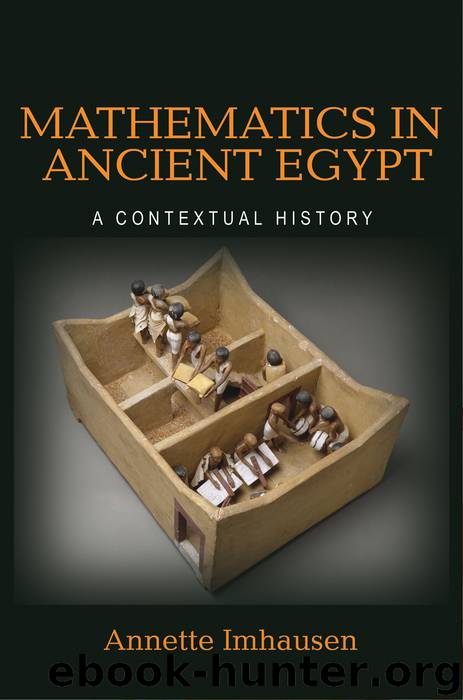Mathematics in Ancient Egypt by Imhausen Annette

Author:Imhausen, Annette
Language: eng
Format: epub
Publisher: Princeton University Press
Published: 2016-04-28T16:00:00+00:00
NEW KINGDOM
Many of today’s most famous kings and queens of Egypt ruled during the New Kingdom (1550–1069 BCE), rendering it one of the best-known periods of ancient Egypt in modern times.1 Because it is more recent than Egypt’s previous two periods of bloom, it is not surprising that many more documents are extant. Monumental inscriptions enabled Egyptologists to get a fairly good picture of the political history in this time. Royal and private tombs have provided ample information about religion. Furthermore, due to the use of ostraca (stone or pottery shards) as cheap writing material, there is, besides the papyri, a second medium to record daily life issues. Ostraca are more robust than papyrus, and thus thousands of them are still extant and allow us better insights into daily life affairs. Although ostraca have been used from the Old Kingdom on, it is during the New Kingdom that they became more popular.
Within the New Kingdom, several subperiods can be distinguished. The New Kingdom begins with the expulsion of the Hyksos by Ahmose (1550–1525 BCE), the founder of the Eighteenth Dynasty. In the following reigns of this dynasty, the territory of Egypt was reestablished, and Egypt reaches its third cultural peak. This is the last period of pharaonic Egypt, in which, at least temporarily, Egypt held an influential political position. A major break during the New Kingdom was caused by Amenhotep IV, better known as Akhenaten, who strongly promoted the god Aton and moved the capital from Thebes to a place now known as Tell el Amarna. However, the fundamental changes that Akhenaten tried to bring about were short lived and already reversed by the immediately following rulers, Smenkhkara (about whom we know next to nothing), Tutankhamun (whom we only know because of his outstanding tomb), Ay, and Horemheb, the last kings of the Eighteenth Dynasty. The following Nineteenth and Twentieth Dynasties are also known as the Ramesside Period, a name that was derived from that of the majority of their kings, “Ramses.” The Nineteenth Dynasty begins with Ramses I (1295–1294 BCE), and the Twentieth Dynasty ends with Ramses XI (1099–1069 BCE). Between these two kings, Egypt became, for the last time, a distinguished independent power, with its peak presumably during the long regency of Ramses II (1279–1213 BCE).
The wealth of evidence extant from the New Kingdom also includes a variety of information on the Egyptian officials during this time. In the later New Kingdom, the education of scribes was systematized, as evidence from the genre of school texts seems to indicate. A large variety of compositions were used as models, which were presumably copied by scribes for instruction.2 Rather surprisingly, there are no extant mathematical handbooks from this period. The only two mathematical texts extant are two ostraca, both of which show no more than a few incomplete lines of text.3 Despite this, there is still evidence within the school literature that mathematics remained a key feature of scribal education. In addition, ration lists and several other documents prove that mathematical techniques were still an important part within the daily life of a scribe.
Download
This site does not store any files on its server. We only index and link to content provided by other sites. Please contact the content providers to delete copyright contents if any and email us, we'll remove relevant links or contents immediately.
| Applied | Geometry & Topology |
| History | Infinity |
| Mathematical Analysis | Matrices |
| Number Systems | Popular & Elementary |
| Pure Mathematics | Reference |
| Research | Study & Teaching |
| Transformations | Trigonometry |
Weapons of Math Destruction by Cathy O'Neil(5038)
Factfulness: Ten Reasons We're Wrong About the World – and Why Things Are Better Than You Think by Hans Rosling(4022)
Factfulness_Ten Reasons We're Wrong About the World_and Why Things Are Better Than You Think by Hans Rosling(2754)
Descartes' Error by Antonio Damasio(2733)
A Mind For Numbers: How to Excel at Math and Science (Even If You Flunked Algebra) by Barbara Oakley(2691)
TCP IP by Todd Lammle(2641)
Applied Predictive Modeling by Max Kuhn & Kjell Johnson(2480)
Fooled by Randomness: The Hidden Role of Chance in Life and in the Markets by Nassim Nicholas Taleb(2413)
The Book of Numbers by Peter Bentley(2404)
The Tyranny of Metrics by Jerry Z. Muller(2401)
The Great Unknown by Marcus du Sautoy(2186)
Once Upon an Algorithm by Martin Erwig(2149)
Easy Algebra Step-by-Step by Sandra Luna McCune(2117)
Practical Guide To Principal Component Methods in R (Multivariate Analysis Book 2) by Alboukadel Kassambara(2093)
Lady Luck by Kristen Ashley(2073)
Police Exams Prep 2018-2019 by Kaplan Test Prep(2034)
Linear Time-Invariant Systems, Behaviors and Modules by Ulrich Oberst & Martin Scheicher & Ingrid Scheicher(1983)
All Things Reconsidered by Bill Thompson III(1960)
Secrets of Creation, Volume 1: The Mystery of the Prime Numbers by Watkins Matthew(1864)
